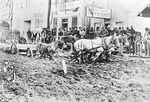Больше чем жизнь (Russian) ("Larger than life") | ||||||||
| Capital | Davydovsk | |||||||
| Largest City | Belokonsky | |||||||
| Other Cities | Deltovy, Faraon, Voroninsky | |||||||
| Language Official |
Russian | |||||||
| Others | English, Finnish, Ukrainian | |||||||
| Religion Main |
Eastern Orthodox | |||||||
| Others | Buddhists, Catholics, Lutherans | |||||||
| Ethnic Groups Main |
Russians and Ukrainians | |||||||
| Others | Finns, Norwegians, Yugoslavs | |||||||
| Demonym | Yukoner, Yukonets | |||||||
| Governor | Daniil Paslosky (Evergreens) | |||||||
| Area | 461,519 km² (405,530 кв. врс) | |||||||
| Population | 1,954,704 (2017 Census) | |||||||
| Established | June 13, 1898 (Russian Empire) | |||||||
| Admission | 1941 | |||||||
| Time Zone | White Standard Time (UTC-9) | |||||||
| Summer | White Summer Time (UTC-8) | |||||||
| Abbreviations | AK-YK, Юк. (Yuk.) | |||||||
The Yukon Governorate (Russian: Юконская губерния, Yukonskaya guberniya), colloquially known as Yukon (Юкон), is a governorate of Alaska. Located in the nation's northeast, the governorate encompasses the area of the Upper Yukon River (which also provides the governorate's name). Yukon is the second largest governorate in area (after the Far North) and is one of the few Alaskan governorates to be landlocked.
History
For centuries, Yukon was populated by the many Athabaskan-speaking peoples. Despite being in contact with Europeans since the early 19th Century, the region remained untouched until the later part of the century.
Beginning in the 1880s, the area that would become Yukon became a hub for railroads connecting the northern colonies with the southern ones. The region's significance would change with the discovery of gold across the entire Yukon River Basin. As the economy and population boomed, the area would be organized into an oblast (region) of the Russian Empire.

Davydovsk (1898).
During the Alaskan Wars, the Yukon Oblast attempted to gain independence. These hopes were short-lived, as the Communists gained control over the Lower Yukon and going as far east as the colonial capital Davydovsk. The New Archangel Regime responded by occupying the Upper Yukon and forcing the Yukon government to comply (effectively ending Yukon independence). The administration of the territory would be divided between the Communists in the north and New Archangel in the south (with the area west of the 147th Meridian effectively being ceded to the Communists).
Following the establishment of the modern ADFR in 1929, Yukon would remain in a political limbo with the Communists. As tensions flare up following Germany's invasion of the Soviet Union in June 1941, President Taras Ferley would openly advocate for the admission of Yukon as a full governorate for the first time in the waning years of his presidency. The territory is fully liberated in 1944, ending the decades-long political limbo.
Presidents Ivan Gnatyshin and Igor Voronov would note the importance of Yukon for the reunified nation. Federal funding would be used to reconstruct the governorate's infrastructure and mining industry.
| |||||||||||||||||||||||




